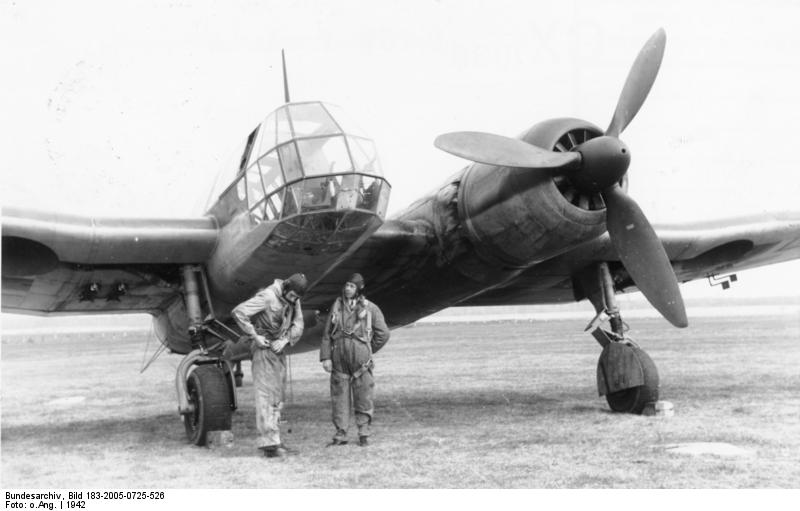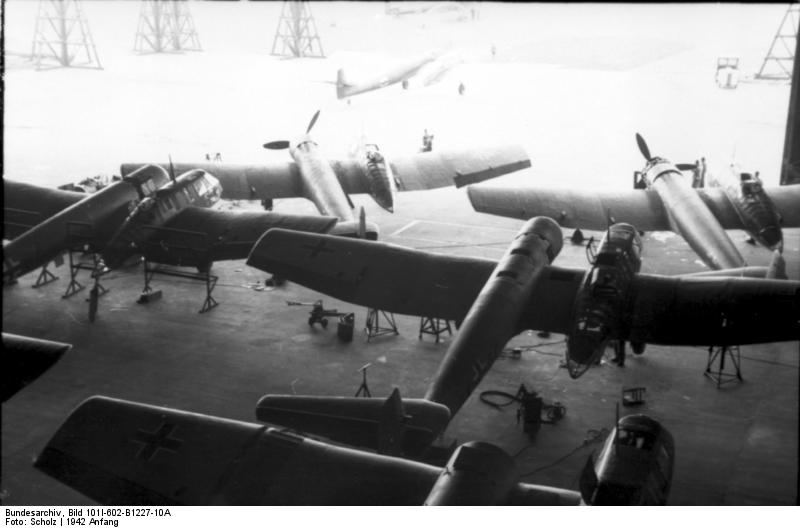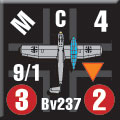| Stolen Fleets:
Germany’s Asymmetric Stuka
by Mike Bennighof, Ph.D.
March 2020
 As German Air Force doctrine evolved in the 1930’s, so did requirements for more specialized aircraft. Since the Air Force claimed jurisdiction over everything that flew, the Army insisted that it fulfill its cooperation missions, close air support as well as tactical reconnaissance. As German Air Force doctrine evolved in the 1930’s, so did requirements for more specialized aircraft. Since the Air Force claimed jurisdiction over everything that flew, the Army insisted that it fulfill its cooperation missions, close air support as well as tactical reconnaissance.
In early 1937, the Air Ministry issued specifications for a short-range light reconnaissance plane with a three-man crew and the widest possible line of sight for observation. The favored Arado firm appears to have had access to these earlier than the other manufacturers involved, Focke-Wulf and Hamburger Flugzeugbau (soon to take its corporate parent’s name, Blohm und Voss).
Arado’s entry, the Ar.198, was an exceedingly ugly aircraft. It had a single engine with a shoulder-high wing; the pilot and gunner/radio operator were seated above the wing while the observer rode in the plane’s wide, glassed-in belly. The plane turned out to be underpowered, unstable and difficult to handle, though it did offer excellent visibility. Despite Arado’s illicit head start, the Ministry rejected the plane.
Focke-Wulf’s lead designer Kurt Tank led the team designing their entry, the Fw.189. The other design teams believed that their plane needed to have one engine, though the request for proposals did not explicitly state this. And so Tank’s plane had a twin-boom design, with the crew compartment in the middle of the single wing between the two engines.

A late-model BV.141 (with improved engine).
The “Flying Eye” won the competition, and eventually over 800of them would be built. The plane proved very capable for its tasks, and a few would be modified as night-fighters in the closing days of the war. Despite its odd appearance the Fw.189 was highly maneuverable, able to elude enemy fighters in the hands of a good pilot. A successful plane, the Flying Eye fell out of production in 1944 in favor of more fighter planes.
The third entry, designed by Richard Vogt for Hamburger Flugzeugbau, took a radically different approach. Believing the plane limited to one engine, Vogt solved the problem of maximum visibility with an asymmetric design that place the engine in a boom with the separate, almost totally glazed crew compartment to its right. That would not only give the crew unimpeded views, it would cancel out the torque generated by the propeller.
The strange design arrived too late for the recon place competition, but Ernst Udet, head of German Air Force research and development, decided to encourage the new approach and Vogt’s bosses agreed to pay for a prototype. The plane flew in February 1938 under the designation Ha.141, and did so extremely well. Udet himself, a World War One fighter ace, took the controls and came away impressed enough to let a contract for three prototypes, eventually amended to include the first plane so that the firm’s investment would be recouped.
The Air Force demanded a number of changes, starting with the crew nacelle which was replaced with a design based on that of the Fw.189. The plane gained an armament of four machine guns and four small bombs, and a bomb sight. The Air Force, urged on by Udet, finally placed an order for five more aircraft in 1939 and further testing commenced in 1940.
Those trials showed the plane to be underpowered, but Vogt had already re-worked the plane to accommodate a larger engine. Five more planes to this new standard, now designated Bv.141B, were ordered in 1941 but the bigger engine produced structural and vibration problems, necessitating more adjustments. More work had to be done to modify the armament so that cordite fumes didn’t fill the glassed-in crew compartment, and the tail was re-designed to lower the chances of the tail gunner shooting part of it off.

Udet's vision: a whole squadron of BV.141 recon planes.
More pre-series planes arrived at various testing grounds, and in the autumn of 1941 Udet ordered an operational squadron formed and dispatched to the Eastern Front. Udet faced a psychological crisis at the time, as his chief Hermann Goering had reacted to criticism over the Air Force’s poor performance in the ongoing campaign against the Soviet Union by tossing Udet under the proverbial bus and the dashing playboy Udet had compounded things by cheating on his long-time girlfriend with the daughter of the American ambassador. Udet killed himself amid a morning of heavy drinking, and with him died the Bv.141’s only supporter within the Air Force command hierarchy.
Focke-Wulf’s plant soon suffered bomb damage, and the production line for the big Fw.200 Kondor long-range reconnaissance plane shifted to Blohm und Voss, squeezing out the capacity to build any more Bv.141 aircraft. The odd recon plane used the same engine as the Fw.190 fighter, which had priority for the power plants. Plans for the Bv.141 squadron were formally cancelled in the spring of 1942, ending the plane’s development.
 Undeterred, Vogt continued to develop further proposals for his basic design. The Air Force asked for proposals for an aircraft to replace the Junkers Ju 87 dive bomber, and this time the Blohm und Voss team met the submission deadline. Their plane, designated Bv.237, was a smaller though heavier craft, with the same engine and layout as the Bv.141. It would have just one crewman rather than the three of the recon plane, carrying two 20mm cannon and two machine guns. Undeterred, Vogt continued to develop further proposals for his basic design. The Air Force asked for proposals for an aircraft to replace the Junkers Ju 87 dive bomber, and this time the Blohm und Voss team met the submission deadline. Their plane, designated Bv.237, was a smaller though heavier craft, with the same engine and layout as the Bv.141. It would have just one crewman rather than the three of the recon plane, carrying two 20mm cannon and two machine guns.
Germany’s Supreme Leader approved the design in early 1943, but no prototype was ever built. That summer the Air Ministry ordered Blohm und Voss to cease work on all new projects, but Vogt quietly continued with the design and had produced a wooden mockup by late 1944.
That development never ends in our Long War alternative history (Plan Z); in our story Udet reconciles with his beloved Ingelein and is never blamed for losing the Russian campaign, since the Germans win in our story. The Bv.141 goes into serial production in mid-1941, and the dive bomber version (along with the proposed ground-attack plane) appears in mid-1943. While an upgrade over the Ju 87, it’s not much of an improvement and the German Air Force would have been already seeking its next generation of attack plane.
The plane appears in Plan Z: Stolen Fleets, as a carrier-borne dive bomber that helps equip the new German aircraft carriers. It has about the same range as the carrier-borne Ju 87 models and is enormously more capable of defending itself, but packs less of a bomb load.
You can order Plan Z: Stolen Fleets right here.
Sign up for our newsletter right here. Your info will never be sold or transferred; we'll just use it to update you on new games and new offers.
Mike Bennighof is president of Avalanche Press and holds a doctorate in history from Emory University. A Fulbright Scholar and NASA Journalist in Space finalist, he has published over 100 books, games and articles on historical subjects.
He lives in Birmingham, Alabama with his wife, three children and his dog, Leopold.
|
